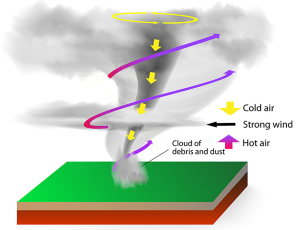Tornado FAQs
 What is a tornado?
What is a tornado?
A tornado is a narrow, violently rotating column of air that extends from the base of a thunderstorm to the ground. Because wind is invisible, it is hard to see a tornado unless it forms a condensation funnel made up of water droplets, dust and debris. Tornadoes are the most violent of all atmospheric storms.
Where do tornadoes occur?
Tornadoes occur in many parts of the world, including Australia, Europe, Africa, Asia, and South America. The highest concentrations of tornadoes outside the U.S. are Argentina and Bangladesh.
How many tornadoes occur in the U.S. each year?
About 1,200 tornadoes hit the U.S. yearly. Since official tornado records only date back to 1950, we do not know the actual average number of tornadoes that occur each year. Plus, tornado spotting and reporting methods have changed a lot over the last several decades.
Where is tornado alley?
Tornado Alley is a nickname invented by the media for a broad area of relatively high tornado occurrence in the central U.S. Various Tornado Alley maps look different because tornado occurrence can be measured many ways. Please remember, violent tornadoes do happen outside "Tornado Alley" every year.
When are tornadoes most likely?
Tornado season usually refers to the time of year the U.S. sees the most tornadoes. The peak "tornado season" for the Southern Plains is during May into early June. On the Gulf coast, it is earlier during the spring. In the northern plains and upper Midwest, tornado season is in June or July. But, remember, tornadoes can happen at any time of year. Tornadoes can also happen at any time of day or night, but most tornadoes occur between 4–9 p.m.
Does hail always come before the tornado? Rain? Lightning? Silence?
Not necessarily, Hail, or any particular pattern of rain, lightning or calmness, is not a reliable predictor of tornado threat. Rain, wind, lightning, and hail characteristics vary from storm to storm, from one hour to the next, and even with the direction the storm is moving with respect to the observer.
How long does a tornado last?
Tornadoes can last from several seconds to more than an hour, but most tornadoes last less than 10 minutes.
What does a tornado sound like?
That depends on what it is hitting, its size, intensity, closeness and other factors. The most common tornado sound is a continuous rumble, like a nearby train. Sometimes a tornado produces a loud whooshing sound, similar to a waterfall, or the noise of open car windows while driving very fast. Tornadoes which are tearing through densely populated areas may be producing all kinds of loud noises at once, which collectively may make a tremendous roar. Just because you may have heard a loud roar during a damaging storm does not necessarily mean it was a tornado. Any intense thunderstorm wind can produce damage and cause a roar.
How is tornado strength rated?
The most common and practical way to determine the strength of a tornado is to look at the damage it caused. From the damage, we can estimate the wind speeds. An "Enhanced Fujita Scale" was implemented by the National Weather Service in 2007 to rate tornadoes in a more consistent and accurate manner. The EF-Scale takes into account more variables than the original Fujita Scale (F-Scale) when assigning a wind speed rating to a tornado, incorporating 28 damage indicators such as building type, structures and trees. For each damage indicator, there are 8 degrees of damage ranging from the beginning of visible damage to complete destruction of the damage indicator. The original F-scale did not take these details into account. The original F-Scale historical data base will not change. An F5 tornado rated years ago is still an F5, but the wind speed associated with the tornado may have been somewhat less than previously estimated. A correlation between the original F-Scale and the EF-Scale has been developed. This makes it possible to express ratings in terms of one scale to the other, preserving the historical database.
How do tornadoes form?
The truth is that we don't fully understand. The most destructive and deadly tornadoes occur from supercells, which are rotating thunderstorms with a well-defined radar circulation called a mesocyclone. Tornado formation is believed to be dictated mainly by things which happen on the storm scale, in and around the mesocyclone. Recent theories and results from the VORTEX2 program suggest that once a mesocyclone is underway, tornado development is related to the temperature differences across the edge of downdraft air wrapping around the mesocyclone. Mathematical modeling studies of tornado formation also indicate that it can happen without such temperature patterns; and in fact, very little temperature variation was observed near some of the most destructive tornadoes in history on 3 May 1999. We still have lots of work to do.
Source: National Weather Service